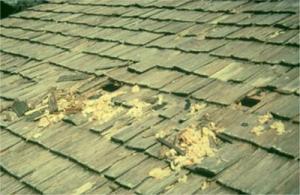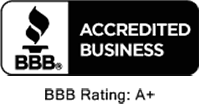Raccoons Preventing and Controlling Property Damage
Raccoons are intelligent, curious, brazen at times, and even appear to be cute and cuddly. Make no mistake, raccoons are not domesticated like a cat or dog, they are wild animals. These seemingly friendly critters have sharp teeth and claws and will get nasty if they are cornered by a person or another animal like a dog. Raccoons are wild animals and no attempt should be made to pick them up or pet them, even if they appear tame.
Raccoons are common inhabitants of urban and semi-urban areas Minnesota. Because local ordinances provide raccoons with near-total protection in many areas, dealing with damage or nuisance situations in those settings presents some unique problems.
Identification
Because raccoons sleep during the day and are active at night, property owners seldom see them causing damage. However their distinctive tracks or the type of damage caused may help identify whether raccoons are the problem.
Raccoons will raid garbage cans in search of food, and this may be mistaken for a problem caused by free-running dogs. Uncapped and unused chimneys are commonly used for denning in urban areas. Raccoons may occasionally gain access to attics or outbuildings. They will also roll up freshly laid sod in search of grubs or worms, especially in late summer.
Raccoons may cause considerable damage to gardens or truck crops, particularly sweet corn. They will pull back the husks and eat the corn, and may break off corn stalks as they climb up the stalks to get the ears.
Damage Prevention
Although the raccoon may cause numerous nuisance problems, there are a number of ways to deter or prevent additional damage.
Garbage cans:
Homeowners having a problem with raccoons in garbage should store the garbage in a stout metal or plastic container and close the lid tightly. It should be wired, clamped or tied shut if necessary. If the problem persists it may be necessary to tie the can to a post or other solid object to prevent it from being tipped over, or to put the garbage cans inside the garage or outdoor shed. Raccoons may be attracted by dog or cat food left out overnight, and it may be necessary to feed pets indoors or to provide food only during the day.
Feeding of raccoons is strongly discouraged and is prohibited in some areas. Raccoons that have been intentionally fed tend to become very bold and dependent on people and can become especially troublesome in the neighborhood where the feeding occurs.
Attics:
If raccoons are denning in an attic, the best way to get rid of them is to wait until all raccoons leave the attic, and then repair the hole where they are gaining access. Raccoons normally leave their dens nightly to forage. However, in the spring and early summer, young raccoons may be present that are unable to leave the den. In winter, raccoons may remain in their dens for weeks at a time during very cold or stormy weather, coming out only on “warm” nights. Mothballs or moth crystals placed in nylon mesh bags or pie tins in an enclosed area will create fumes that may help repel the raccoons. Several pounds of mothballs or crystals would be needed for an average size attic. If the raccoons will not leave on their own, removal with a live trap may be necessary.
Chimneys:
If raccoons are lodging in an unused chimney, it may be possible to smoke them out by lighting a SMALL fire in the fireplace. However, this technique may not work if young raccoons are present, or the raccoon may climb part way up the chimney and stop causing smoke to back up into the house. You should be prepared to quickly extinguish the fire if this becomes a problem. Placing mothballs or moth crystals up the flue or periodically banging the fire box or damper over a period of several days may encourage the mother raccoon to relocate the litter if young are present. Some professional chimney cleaners also specialize in removing animals, or the homeowner can wait until the young are weaned (between two and four months of age). At that time, they will leave on their own. In any case, once the raccoons are gone, the chimney should be covered with a commercial cap to prevent future problems.
Lawn and Sod:
Raccoons roll or pull up freshly laid sod, beginning in late June or early July, in search of worms and grubs. If the new sod does not cover much area, it may be possible to put wooden stakes or wire pins through the ends of the rolls until the roots get a good firm hold. Usually, the most practical alternative is to remove the raccoon(s).
Gardens:
Raccoons raiding vegetable gardens may be excluded with a single or double wire electric fence, if the area is fairly isolated. Single wire fences should be 6 inches off the ground or a double wire fence at 5 and 12 inches may be more effective. The fence can be activated at dusk and turned off after daybreak. In residential areas where children may be present, electric fences may not be the most practical alternative. No effective repellents or frightening devices are known for raccoons in outdoor areas.
Removal
In urban and suburban areas, cage or boxtraps are generally the most practical removal devices. Foot traps may be used in some areas, especially if they can be set in water. Some cities have ordinances prohibiting the use of certain types of traps, so local authorities should be contacted before any removal efforts are begun.
State law allows property owners to control raccoons that are causing damage or injury on their property. They may control these animals without a trapping license or permit. If the animal is killed, it must be reported to the local DNR Conservation Officer within 24 hours.
A live trap should be at least 10″ x 12″ x 32″. It can be baited with fish, chicken, fish flavored cat food or canned tuna. The mesh must be small enough so the raccoon cannot reach through the wire and get the bait–one-half inch or smaller will be adequate. Most of the bait should be placed inside the trap near the back, but a few morsels should be placed in front of and just inside the trap. Live traps are available for rent or loan from rental companies and some animal shelters and nature centers, or they can be purchased or made.
Although shooting is often an effective control technique in rural areas, it is prohibited in towns and cities.
If a foothold type trap is used, a number one and one-half coilspring or “stoploss” trap should be used, preferably in a drowning set. These traps are best confined to water in semi-urban areas, and may be illegal in some areas.
Diseases
Raccoons are known to carry rabies and parasites. Although rabies is quite rare in raccoons in Minnesota, no bite by a wild carnivore should be ignored. Raccoons are normally not aggressive, but will defend themselves if captured or cornered. If you are bitten by a raccoon, every attempt should be made to capture or kill it (without damage to the head) so that it can be tested for rabies by the Minnesota Department of Health. Medical treatment and advice should also be sought.
Recently, it has been found that a common roundworm parasite called Baylisascaris procyonis of raccoons can cause human health problems under certain circumstances. These parasites live in the raccoon intestine and shed microscopic eggs which are passed in the raccoon feces. These eggs can become infective to people or other animals after about 30 days. The greatest potential for problems is for people who may come into close contact with areas contaminated with raccoon fecal material, particularly small children who may place dirty hands or objects in their mouths.
In wild populations, distemper is the most important disease causing raccoon mortality, but it does not affect humans or properly immunized pets.
Remove Raccoons From Your House or Property
For the average homeowner, unfamiliar with trapping raccoons, it is advisable to hire a professional wild animal control expert to remove the animal. The professional will have the proper equipment to accomplish the task and will be able to tell if a trapped female is nursing its young. This is very important because you don’t want to leave young behind to starve.
The professional will also have the means to euthanize the animals, since releasing them elsewhere is prohibited by law. Released animals may return or present a problem to someone else and, in fact, the animal you have trapped may have been deliberately released near you. Release of animals is a major factor in the dissemination of numerous diseases to other animals.
Got a Raccoon Problem? Safely Remove Raccoons from your Minnesota home. We Humanely Remove Raccoons from your House or Property.
The best prevention advice is to stay away from wild animals, live or dead, and call a Minnesota Wild Animal Removal Expert immediately. If your pet is acting ill or strange, contact your veterinarian immediately.
Source: Minnesota DNR – Living with wildlife







